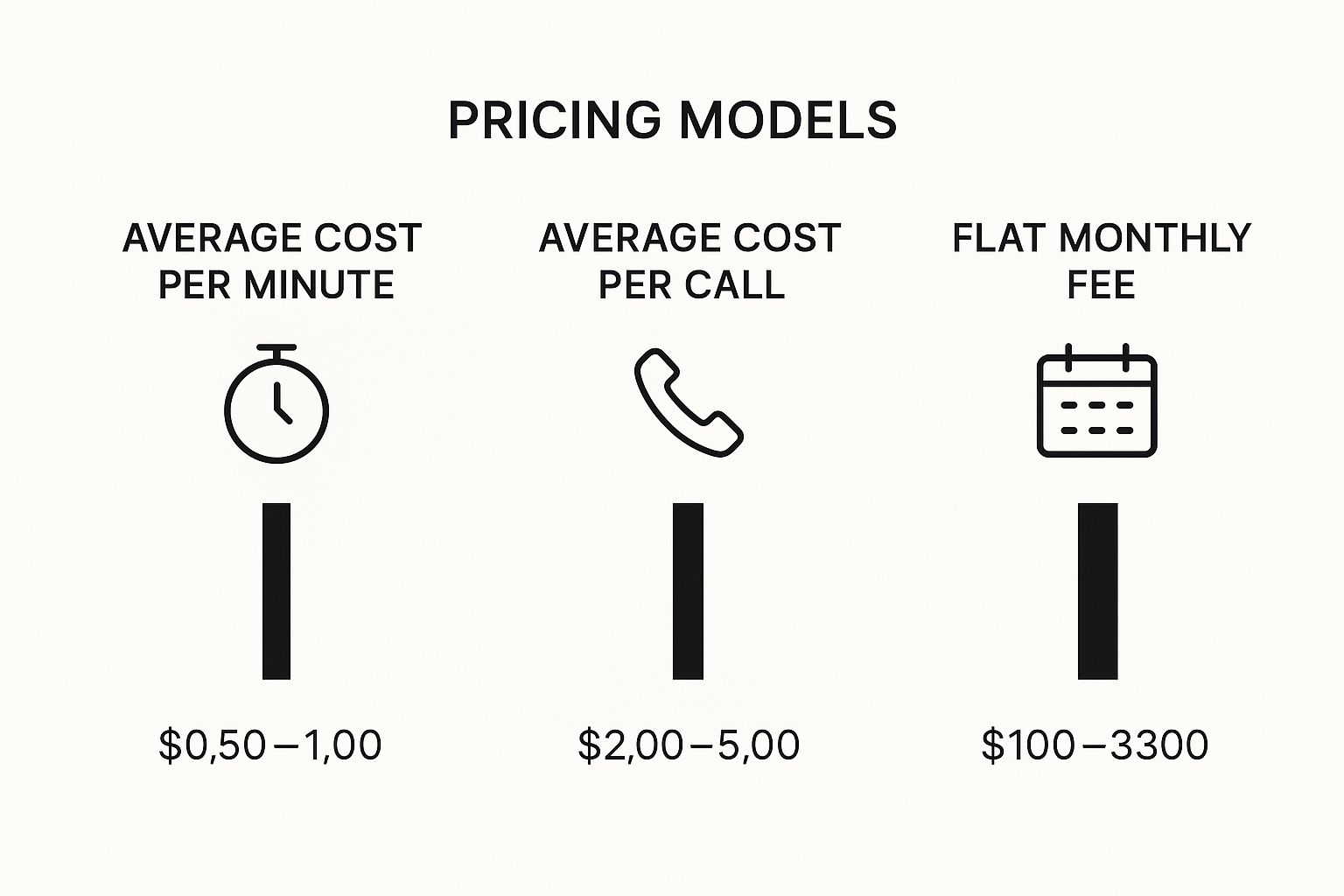Figuring out the cost of an answering service can feel a lot like trying to choose a new cell phone plan. You're faced with a bunch of options: should you pay for every single minute you use, or is it smarter to lock in a flat monthly rate so your bill is always predictable?
Getting a handle on these pricing models is the first step to making a smart call for your business. Most services will cost you somewhere between $100 to over $1,000 per month, but that range depends entirely on your call volume and the specific features you need.
At the end of the day, it all boils down to three main ways answering services charge for their time. Each one is built for a different kind of business with its own unique call patterns. If you pick the right one, you'll avoid paying for services you don't use or getting hit with surprise fees when your phone starts ringing off the hook.
Let's break them down:
This infographic gives you a quick visual breakdown of how the average costs stack up against each other.

As you can see, per-minute pricing offers the most detailed billing, while flat-rate plans provide a stable, though often higher, baseline cost for predictable budgeting.
To give you a better feel for what to expect, we can look at the different pricing models side-by-side.
This table breaks down the three main models to help you see which one might be the best fit for your company's call volume and budget.
Each model has its place. The key is matching the structure to how your business actually communicates with its customers.
So, what are businesses actually paying? For most small to mid-sized companies, the monthly bill usually lands somewhere between $100 and $500. This covers a wide range of needs, from basic message-taking to more comprehensive virtual receptionist duties.
The secret to finding the right plan isn’t just chasing the lowest price. It’s about aligning the pricing model with your company’s real-world call volume and communication needs.
Recent industry data gives us a clearer picture. In the United States, a full-service plan with live agents typically runs from $1.12 to $1.43 per minute. If your call volume is lower or comes in unpredictable spurts, per-call rates are usually between $1.39 and $2.69 per call. These numbers really drive home how important it is to analyze your own call data before signing any contracts. For a deeper dive, you can find more 2025 cost breakdowns that show how these figures vary for different business sizes.
Ultimately, whether you just need someone to grab messages after hours or a full-blown virtual receptionist who can schedule appointments and manage your calendar, there’s a plan out there for you. In the next sections, we'll dig into each of these models to help you find the most cost-effective solution for your business.

Knowing the different pricing models is one thing, but figuring out which one actually fits your business is where the rubber meets the road. The perfect plan for a high-volume HVAC company would probably be a terrible fit for a boutique law firm that handles fewer, more complex calls.
Your company’s unique call patterns are the key. How many calls do you get? How long do they last? What actually happens on these calls? The answers will point you toward a structure that saves you money and away from one that bleeds your budget dry.
Let's move past the theory and see how these plans play out in the real world. We’ll walk through three common business scenarios to help you see which model makes the most sense for your day-to-day operations.
Think of per-minute pricing like your electricity bill—you pay for exactly what you use, down to the second. This model is a fantastic fit for businesses where call lengths are all over the map, from quick questions to lengthy, in-depth conversations.
Take a small therapy practice, for instance. Their inbound calls are a real mixed bag:
Let's say in one month, the practice gets 80 short calls (averaging 1.5 minutes) and 5 long calls (averaging 12 minutes). Their total usage comes out to 180 minutes. At a rate of $1.40 per minute, their monthly bill is a clean $252. They aren't getting dinged for those quick administrative calls, only paying for the agent's time.
A per-minute plan offers the most precise billing, making it a cost-effective choice for businesses whose customer interactions are substantive and vary in length, rather than being quick, repetitive tasks.
This structure works beautifully here because the practice only pays for the time an agent is actively engaged. They avoid the trap of a per-call plan, which would charge the same flat fee for a 30-second reschedule as it would for a 15-minute intake call.
Now, let's switch gears to a per-call model. This one is refreshingly simple: one call, one charge. It doesn't matter if the call is one minute or five. It's built for businesses that field a high volume of transactional calls that are short, sweet, and follow a predictable script.
Picture a busy HVAC company during a summer heatwave. The phone is ringing off the hook with service requests. Nearly every call follows the same simple pattern:
These calls are uniform and fast, usually lasting just two or three minutes. If the company handles 250 of these service calls in a month at a rate of $2.25 per call, their bill is a predictable $562.50. They can rest easy knowing a few longer-winded customers won't suddenly inflate their costs.
For this type of business, the per-call model provides pure budget certainty. They know exactly what each call costs, which makes financial planning a breeze, especially during their craziest seasons.
Finally, we have the flat-rate subscription. This works just like your cell phone plan—you pay a fixed monthly price for a set bucket of minutes or calls. It’s designed for businesses that have a steady, predictable call volume and want to lock in their monthly expense with no surprises.
Let's use a property management company as our example. They get a consistent flow of calls every month for maintenance requests, rental inquiries, and vendor follow-ups. Their volume doesn't swing wildly, typically hovering around 400 calls that add up to about 750 minutes per month.
A provider offers them a plan that includes 800 minutes for $900 a month. This is a perfect match.
This model isn't about tracking every second; it's about securing reliable service capacity at a fixed cost. It’s the go-to choice for any business that has a good handle on its call data and can confidently pick a usage tier that fits. The trick is simply choosing a plan that comfortably covers your average volume so you're not constantly paying expensive overage charges.

The first quote you get from an answering service is just the starting line. It’s a lot like buying a new car—the sticker price looks great, but that number rarely reflects what you’ll actually pay once you add the features you really need. To budget accurately and avoid nasty surprises on your monthly bill, you have to understand what pushes that price up.
Think of it as ordering a pizza. The plain cheese is one price, but every single topping costs extra. In the world of answering services, those "toppings" are the specialized skills, extra hours, and complex tasks your business requires.
These services have become a massive part of modern business communication. The global market was valued at around $1.168 billion in 2025, largely because small and medium-sized businesses need professional, responsive support without hiring in-house. Knowing what really drives answering service pricing is the key to making a smart, cost-effective choice.
The biggest cost driver, by far, is the level of expertise required from the agents handling your calls. Basic message-taking is one thing. But if you have complex needs, you'll be paying for specialized training—and that always comes at a premium.
A medical practice is a perfect example. They can't just hire any service; they need agents trained in HIPAA (Health Insurance Portability and Accountability Act) protocols. This is non-negotiable. It guarantees patient information is handled securely and confidentially, but the rigorous training and secure systems required will significantly increase the cost.
Other common specializations that will pad your bill include:
When your service needs to be active is another huge factor. Many businesses get by just fine with standard 9-to-5, Monday-to-Friday coverage. Others need someone ready to answer the phone at all hours.
Expecting 24/7/365 availability means paying for agents to work nights, weekends, and holidays. This round-the-clock coverage is a premium service and will always be more expensive than a basic business-hours-only plan.
It’s simple supply and demand. Fewer agents want to work the overnight shift, so they get paid more. If your business—like an emergency plumbing service or a national e-commerce store—needs to capture leads at 3 AM on a Sunday, that constant availability will be a major line item on your monthly bill.
How an agent handles a call directly impacts how long they're on the phone, which in turn affects your costs—especially on a per-minute plan. A simple "take a name and number" script is quick, easy, and cheap.
But the moment you introduce a more complex workflow, you start adding minutes and dollars to every call. A script that involves these tasks will dramatically increase agent time and your final bill:
Each of these tasks adds precious time to every single call. The more you ask an agent to do beyond taking a simple message, the more you should expect your bill to climb. It’s a universal principle for digital services; just like with answering service pricing, understanding the true cost of something like a domain name requires looking past the flashy intro offer. You can learn more by Decoding Domain Name Charges: What You Actually Pay.
The monthly rate you see advertised for an answering service? That’s often just the starting line. The real cost can be tucked away in the fine print, popping up as setup charges, holiday fees, or painful overage penalties. Getting a handle on these potential extras is the key to budgeting accurately and making sure your final bill isn’t a nasty surprise.
Think of it like your cell phone’s data plan. As long as you stay within your monthly limit, everything is predictable. But the second you stream one too many videos and go over, that per-gigabyte rate can feel astronomical. Answering service overages work the exact same way—the per-minute or per-call rates for anything beyond your plan are almost always much higher, which can inflate your costs in a hurry.
While every provider plays by slightly different rules, some extra charges are pretty common across the industry. These costs aren't always laid out in big, bold letters, so you have to ask about them directly. A few proactive questions upfront can literally save you hundreds of dollars over the life of your contract.
Here are some of the most common surprise fees to look for:
The key to managing answering service pricing is transparency. Never just assume a feature is included in the base price. Always, always ask for a complete breakdown of every single potential charge before you sign on the dotted line.
These little costs can pile up fast, turning what looked like an affordable plan into a major monthly expense. A service that seems like a bargain at first glance might actually cost you more once all the extras are factored in.
To protect your budget, you’ve got to put on your investigator hat. Go into every conversation with a potential provider armed with a list of specific questions. This little bit of prep will help you dig beneath the shiny surface-level pricing and get to the true total cost of the service.
Here's a handy table of common fees and the exact questions you should be asking sales reps to get the full story.
Asking these pointed questions forces providers to be transparent. It’s not just about dodging unexpected fees; it’s about empowering yourself to compare different services on a true "apples-to-apples" basis. This is how you find the best value and the right partner for your business.
Now that you've got a handle on the different pricing models and what they can cost, you're ready to pick the perfect plan. The goal isn't just to find the cheapest option; it's about finding the one that delivers the most value by matching up with how your business actually operates. This means taking a quick, honest look at your communication patterns.
Think of it like buying a work vehicle. A general contractor needs a heavy-duty truck, not a sleek sports car, no matter how good the price on the coupe is. The right answering service plan is the one built for your specific workload. This way, you're not paying for a ton of capacity you never touch or getting blindsided by extra fees for services you absolutely need.
Before you even glance at a provider's pricing page, you need to know your own numbers. Answering a few key questions will instantly narrow your choices and steer you toward the most cost-effective plan. So, grab a notepad or fire up a spreadsheet and dig into these three areas.
What's your average monthly call volume? Pull your phone records from the last three to six months and tally up the inbound calls. That monthly average is the single most important number you need.
How long do your calls typically last? Are most of your calls quick, two-minute questions, or are they longer, more detailed conversations that can stretch to ten minutes or more? Figure out your average call length to get a sense of your total minute usage.
What's the main reason people are calling? Try to categorize your calls. Are they mostly for simple message-taking, booking appointments, qualifying new leads, or walking through technical support? The complexity of the task has a huge impact on which plan is right for you.
Answering these questions gives you a clear snapshot. For instance, a business with 50 calls per month that average 10 minutes each has a completely different profile than one with 500 calls averaging 2 minutes.
Once you have your data, the path forward becomes much clearer. Your self-audit will naturally point you toward one of the main pricing models, making the decision a whole lot easier.
Let's see where your business fits:
You Should Choose a Per-Minute Plan if… Your call lengths are all over the place. If you're handling a mix of brief questions and long client consultations, this model makes sure you only pay for the exact time an agent is on the line. It’s the most precise and often the most economical choice for businesses with substantial, varied interactions.
You Should Choose a Per-Call Plan if… You have a low to moderate call volume, and the calls themselves are short and predictable—think appointment reminders or basic service dispatches. This plan gives you cost certainty, but it can get pricey if your average call time starts creeping up.
You Should Choose a Subscription Plan if… Your call volume and total minutes are pretty consistent from one month to the next. This plan offers the best value because you're buying minutes in bulk at a discount, but it only works if you can confidently pick a tier that covers your typical usage without racking up a bunch of overage charges.
The goal is to find the pricing model where you are paying for value, not waste. A high-volume business on a per-call plan might overpay for thousands of short calls, while a low-volume business on a large subscription plan is paying for minutes it never uses.
Finally, don't forget about the unique demands of your industry. A generic, one-size-fits-all plan might not give you the specialized support you need, which could cost you way more in the long run through lost customers or compliance headaches.
For example, a medical practice needs agents who are HIPAA-compliant, and a financial services firm requires staff trained in security protocols. Businesses with very specific needs, like law firms, often get the best results by looking for providers that specialize. It’s worth taking the time to research answering services specifically designed for law firms to ensure client confidentiality and proper intake procedures are handled correctly.
These specialized services will factor into the overall answering service pricing, but for many professional fields, they're a non-negotiable investment. By thinking about your industry's needs right alongside your call data, you can confidently choose a plan that’s not just affordable, but truly effective for your business.

Even after you've wrapped your head around the different pricing models and potential fees, a few nagging questions always seem to pop up right before you're ready to sign on the dotted line. Getting straight answers to these common queries is often the final piece of the puzzle.
This section is here to tackle those lingering questions head-on. We'll clear up some of the finer points about billing and service levels, making sure you can move forward with total confidence.
This is a big one, especially for smaller businesses that need to stay nimble. The short answer? It depends entirely on the provider. Some answering services will absolutely require a one-year commitment to lock in their best rates.
But the good news is that many modern providers have moved to month-to-month plans. This has become a huge selling point, letting you try a service out without getting locked into a lengthy agreement. You might pay a little more each month for that freedom, but it’s often a small price to pay to avoid being stuck in a contract that no longer makes sense for your business.
When you're on a per-call plan, the definition of a "call" is everything. You definitely don't want to be paying for wrong numbers, spam calls, or immediate hang-ups. Unfortunately, some providers will bill you every single time an agent picks up the phone, no matter what happens next.
This is something you have to get crystal clear on before signing up. The best providers only charge for legitimate interactions—calls where a message is actually taken or a specific task gets done. You should always ask about their policy on:
Get this in writing. It's the only way to make sure you're not paying for calls that bring zero value to your business.
People often use the terms "answering service" and "virtual receptionist" interchangeably, but they're really two different levels of service with two very different price points. Understanding this distinction is critical for setting the right budget.
A basic answering service is focused on one thing: taking messages when you can't. The agents follow a pretty straightforward script to make sure you never miss a call. This is your most budget-friendly option.
A virtual receptionist, on the other hand, acts as a true extension of your front office. This premium service involves more complex tasks, specialized training, and deeper integration with your business tools, which naturally comes with a higher price tag.
A virtual receptionist can handle a whole range of duties that justify the higher answering service pricing, such as:
As a rule of thumb, a virtual receptionist plan can cost anywhere from 25% to 75% more than a basic message-taking plan. That price jump reflects the significant extra value and the more intensive work required from the agents.
Ready to see how an AI-powered receptionist can handle your calls 24/7 for a fraction of the cost? With My AI Front Desk, you get an intelligent system that can schedule appointments, qualify leads, and answer customer questions instantly. Discover the future of business communication at https://myaifrontdesk.com.
Start your free trial for My AI Front Desk today, it takes minutes to setup!








